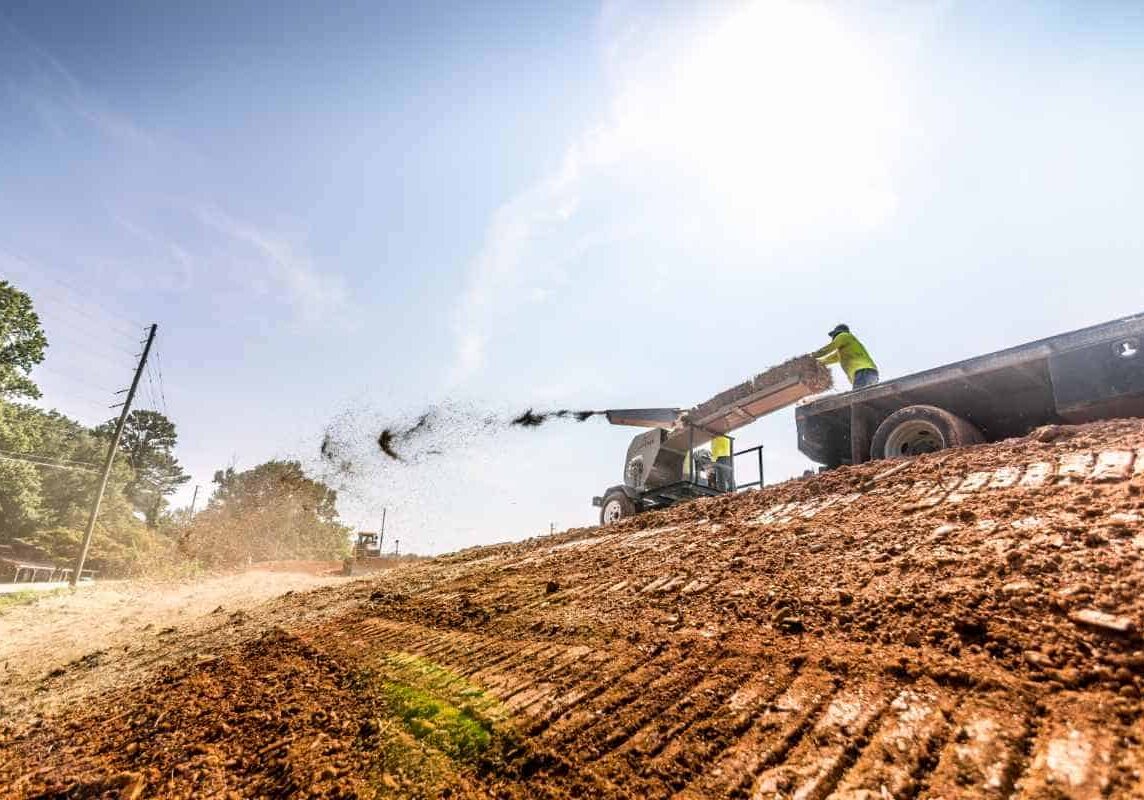The Role of Straw Blowers In Erosion Control

Share this article!
Cover materials like straw play a pivotal role in helping prevent and control erosion in a variety of landscaping projects. Whether you need to stabilize a slope, reduce or control stormwater runoff, or limit excess water at a site, straw blowing can be used to prevent and control these adverse environmental forces from damaging unprotected soil.
Erosion Control In Construction
Straw blowing can be used effectively in the construction industry, especially for areas where large-scale excavation or soil disruption has occurred. Anywhere soil is left unprotected, straw blowing can be used as an efficient method to help prevent soil degradation and the damaging impact of erosion.
For freshly planted areas, straw provides an important barrier from rainfall and for the seeds themselves, working on two fronts: 1) to stabilize the soil and promote revegetation in the area by holding moisture close to the soil, and 2) to physically protect seeds from heavy rainfall, water runoff and wind disturbance.
How To Use Straw To Prevent Erosion
Straw can be used in a variety of ways to prevent erosion. Straw can be blown, using a straw blower, over areas at relatively large distances for fast, efficient erosion control. Another effective erosion control method is using straw mats, however these are typically much more labor intensive to install. Straw wattles, or erosion socks, can also be used to create a perimeter around an area that is at particular risk for erosion, these are often used in conjunction with a straw covering.
Depending on the area and the erosion control needs, one or a variety of these different methods are useful to prevent and control erosion in the landscape.
Straw Blowing For Erosion Control
Straw blowing in particular has a variety of benefits that other erosion control methods lack. Importantly, straw blowing is a quick way to get erosion protection over a large area. Many straw blowers can apply up to 20 tons of straw in as little as an hour, and at distances up to 90 feet. This gives the advantage of both speed and efficiency, as straw blowing can quickly lay down a uniform coverage of straw in the given area.
An application of just one ton of straw per acre has been shown to be almost 100% effective at preventing erosion and soil runoff. And while straw wattles and mats can also help, they are typically more effective for small-scale projects, and their labor intensity generally makes them better suited for more targeted erosion control projects.
How To Keep Straw Mulch From Blowing Away?
One potential downside with straw is that it can be displaced by heavy winds or rains, however, there are several effective methods to keep straw in place after it has been applied. For instance, using wire or mesh netting can hold straw in place, and adding materials like tackifiers or adding moisture to the straw before blowing can help ensure straw stays where it needs to be in the face of unpredictable environmental forces like water erosion. Choosing heavier species of straw can also add protection against unintended straw redistribution.
Straw Wattles vs. Straw Blowing
Straw wattles offer a variety of benefits, and can often be used successfully in tandem with straw blowing to prevent and control erosion around construction sites and landscaping initiatives. Like straw blowing, straw wattles can be used to prevent erosion. Due to their tubed shape, wattles are best used in places where heavy amounts of consistent water runoff occur, such as along steep slopes or along embankments. Straw wattles can effectively stop sediment runoff, helping to prevent soil displacement and degradation.
Straw blowing, by contrast, can be used over a larger area that is threatened by erosion. This quick, uniform straw coverage helps disrupt erosive forces and, when combined with a straw wattle or an erosion sock, can make a perfect pairing to stabilize a slope, hillside, or new construction area.
Straw Mats vs. Straw Blowing
Erosion control mats, also known as straw blankets, are large mats made from biodegradable materials like straw or coconut fibers that can be laid over portions of the landscape to assist with erosion control. The mat acts like a blanket, protecting the exposed soil surface and any seeds below from rainfall disruption and erosion, and can be useful for areas that need immediate, localized erosion control. These mats are generally designed to be staked into the ground to hold them in place, and allowed to slowly degrade over time to add nutrients to the soil while assisting with erosion control.
Erosion control mats are a great choice for smaller areas that experience intense erosion forces such as sharp, steep hillsides or drop offs in construction areas. They’re also great at withstanding foot traffic as well as the elements, so they can provide stop-gap erosion control in areas that need to be accessed simultaneously.
When used in conjunction with erosion control mats, straw blowing can help stabilize larger areas and control stormwater runoff while providing large-scale soil stability. Straw blowing can be used in places where erosion control mats may not make sense, and can generally be used in a wider array of conditions and landscapes Straw blowing also provides an economical solution for areas where it may not be affordable, or timely, to lay the equivalent amount of matting.
Straw Blowing Is Effective For Erosion Control
Straw blowing can provide a highly-effective, efficient solution to reduce the effects of erosion across a variety of environments. The use of straw blowing is not only great for soil stabilization to protect steep slopes against rainfall and environmental forces, it’s also an environmentally-friendly choice to promote soil health and sustainable land management practices from construction to development and more.
